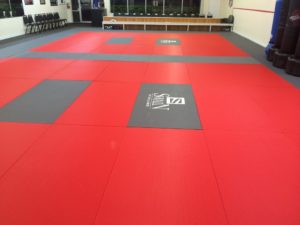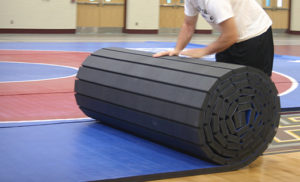When buying mats for your dojo, there are several things to keep in mind, which are specific to the nuances of your training style, Karate. A great mat for Brazilian Jiu Jitsu may not be a good mat for Karate, based on the different training needs from one to the other. Let’s take a look at both the risks and what types of mats are great for karatekas.
Mat Related Risks in Karate
Ground Impact
If you ask people about the purpose of martial arts mats, they will usually give a response about softening the impact of a landing. While karatekas aren’t throwing each other into the mat like Judokas, there is still a risk of injury from falling. This is by far the most common reason for purchasing mats, so I won’t spend much time on this one.
However, it’s important to note what to look for in a mat, in terms of ground impacts and falls. How well a mat absorbs can make a huge difference in whether a person gets injured. As I mentioned though, falling is less of a risk in Karate, but when it happens it is usually less of an impact that Karate or Jiu Jitsu.

Additionally, mats that are too soft can pose an unnecessary challenge in maintaining balance, so thinner mats are often used to allow for greater balance. However, there are many mats that have a good balance of absorbency and firmness, such as puzzle mats.
Knee & Ankle
While firm mats are helpful in Karate for keeping balance, they also help to prevent some specific training injuries. For instance, when performing yoko geri kekomi, you may notice that you are pivoting your foot slightly at the thrust. While some may argue that you shouldn’t do this, and instead plant the foot correctly in the beginning, it may not be that simple when the timing and distance is tight in a kumite. Moreover, a collective of beginner students will make all manner of mistakes. So, as a dojo owner, it’s prudent to make the training environment as safe as possible.
So, what does this have to do with mat selection? Well, when the foot twists in such a way, the foot needs to be free to move. Softer mats tend to lock the foot in place and if the hips are thrown powerfully enough, it can cause damage to the knee or ankle. Firmer mats can alleviate this by allowing the foot to move more freely. In addition, the texture of the mats can have a play in this, especially if you don’t train barefoot.
To get our full breakdown on Martial Arts Mats, fill out the form:
Get the Martial Arts Mats Guide!
Choosing your mats can be a HUGE decision! Take out the guess work with our guide to choosing your mats!Our Top Picks for Karate Mats

Sectional Mats
Sectional mats are very popular these days and it’s easy to see why. They offer a combination of great absorbency, decent firmness, and they look fantastic in the dojo. Additionally, they come in multiple textures. Both Fuji and Dollamur are great places to start, if you’re looking for these mats.
Puzzle Mats
I think nearly everyone has trained on puzzle mats, either at home or at a local dojo. These are great for a few reasons. While the lines are interlocking and do not look as clean as sectional mats, they can still be set in color coded patterns. One such pattern that is nice for Karate is a simple pattern of training lines. These mats are 36 inches wide, so that’s a little too much, even for a tall person (who would require around 28-30 inches). Nonetheless, the 36 inch lines give new karatekas a bit of space, which is great for preventing training accidents. Such as, when Little Johnny misplaces his ushiro geri 45 degrees off his line into Little Sally’s head.
Puzzle mats also have decent absorbency, they are easy to take up or put down, and they stack well. So, if you are sharing space, this isn’t a bad option. Although, the next option may be even better for shared spaces.
Rollout Mats

Rollout mats are quite simple and have a couple of different types available; traditional foam and the more modern flexible style (see the picture).Both types can be very good for training, although the traditional mats have a little more give to them, which isn’t always a good thing. Flexible rollout mats also come in 6 foot sections, so they are easier if you have to roll them up after every training session. If you go with rollout mats, we suggest looking into the flexible style.
So, this post on the best mats for karate is really only a sample of the depth we go into in our Martial Arts Mats Guide. To get that, fill out the form below!
To get our full breakdown on Martial Arts Mats, fill out the form:
Get the Martial Arts Mats Guide!
Choosing your mats can be a HUGE decision! Take out the guess work with our guide to choosing your mats!Disclaimer: Everything written herein should be taken as our opinion and should not be construed as advice. Further, we are not liable for any accidents or injury on mats purchased based on the content of this page.
